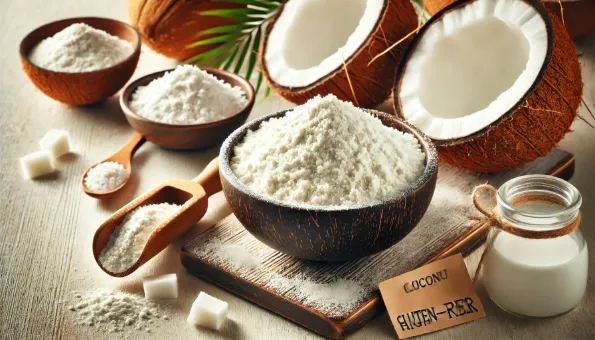Coconut Flour: Gluten-Free High-Fiber Flour Alternative With Distinct Absorption & Mild Coconut Aroma
Made from defatted, dried coconut meat, coconut flour is ultra-absorbent, naturally gluten-free and rich in fiber (~10 g per 2 Tbsp) requiring recipe hydration & structure adjustments.

What Is Coconut Flour?
Coconut flour is a **finely ground powder from dried, defatted coconut meat** left after pressing for coconut milk or oil. It is naturally gluten-free, pale cream colored, mildly sweet and **exceptionally absorbent** due to high fiber.
Nutrition (per 2 Tbsp • 14 g)
| | Amount | Notes |
|---|---|---|
| Calories | 60 kcal | — |
| **Carbohydrate** | 8 g | — |
| – Fiber | 5–6 g | ~18–21% DV |
| Net Carbs | ~2–3 g | After fiber subtraction |
| **Protein** | 2–3 g | Contains all essential AAs in small amounts |
| **Fat** | 2 g | Mainly residual saturated (lauric) |
| Iron | 0.5–0.8 mg | 3–4% DV |
| Manganese | Trace–0.3 mg | Varies |
Low natural sugar; no gluten.
Potential Benefits
- **High fiber (insoluble + some soluble)** supports satiety, bowel regularity & moderates glycemic response.
- **Lower net carbs** vs equal weight wheat flour—useful in reduced-carbohydrate baking strategies.
- **By-product utilization** reduces waste from coconut milk/oil production.
- Naturally **gluten-free & grain-free**, broadening dietary diversity for those with celiac or wheat avoidance.
- Mild natural sweetness lets you **reduce added sugars 5–15%** in some recipes.
Drawbacks & Precautions
- **Extremely absorbent:** Direct substitution for wheat flour fails (dry, crumbly). Requires high egg / binder & liquid ratio.
- High fiber can cause **GI discomfort** (bloating) if large amounts introduced quickly—titrate servings.
- Slight **coconut flavor** may conflict with delicate savory profiles.
- Lower starch & lack of gluten → reduced elasticity & volume; may need blending with other GF flours or added starches for light texture.
- Allergen for rare coconut allergies.
Culinary Uses
- **Baking:** Pancakes, muffins, quick breads, keto/low-carb desserts.
- **Coatings:** Light, fiber-rich dredge for chicken/fish prior to pan-sear (mix with spices & starch for better adhesion).
- **Thickening:** Small amounts to thicken smoothies, shakes, stews (add gradually to avoid clumps).
- **Energy bites / protein bars:** Adds bulk & moisture binding without oats.
- **Blends:** Combine with almond flour, tapioca or oat fiber for improved crumb.
Formulation & Substitution Guidelines
- Use **~1/4–1/3 cup coconut flour per 1 cup wheat flour replaced** *plus* extra liquid and eggs.
- **Hydration rule of thumb:** Add **1 large egg & 2–3 Tbsp liquid for every 2 Tbsp coconut flour** (adjust for vegan by using aquafaba + flax/chia gel + additional moisture).
- Allow batter to **hydrate 5–10 min** before final adjustment—thickening continues.
- For lighter crumb: sift flour, add 1–2 Tbsp starch (tapioca/arrowroot) per 1/4 cup coconut flour.
Technique Tips
- **Weigh if possible** (14 g per 2 Tbsp) for consistency.
- Mix with other dry ingredients before adding liquids to disperse fiber.
- Avoid over-mixing after hydration—structure relies on eggs/binders, not gluten.
- For crisp cookies, reduce eggs slightly & add additional fat (coconut oil/butter). For moist cakes, increase eggs or use yogurt/fruit purée.
Health Context
- High fiber may help **cholesterol & glycemic control** when part of balanced diet.
- Moderate saturated fat content (small per serving) vs whole coconut products.
- Portion: 2 Tbsp (~14 g) provides significant fiber; excessive single-serving amounts (>30 g) can cause GI upset in some.
- Still energy dense—portion control for weight management.
Sustainability Notes
Utilizes **residual press cake** from coconut milk/oil—adding value & reducing waste. Shipping impact from tropical origins exists; buying in bulk & storing well lowers packaging. Choose brands supporting **fair labor & sustainable coconut farming** (intercropping, biodiversity).
Storage
Keep **airtight, cool & dry**; protect from moisture (high fiber clumps). Shelf life: 6–12 months pantry (shorter in humid climates). Refrigeration extends freshness; freeze for long-term (bring to room temp sealed before opening to avoid condensation).
Key Takeaways
✔︎ High-fiber, gluten-free flour alternative
✔︎ Requires added eggs/binders & liquids (1 egg + 2–3 Tbsp liquid per 2 Tbsp flour)
✖︎ Over-absorbent & can cause dryness/GI issues if misused—measure carefully.
- 1. Coconut Flour
Incidental ingredient mentioned in text

